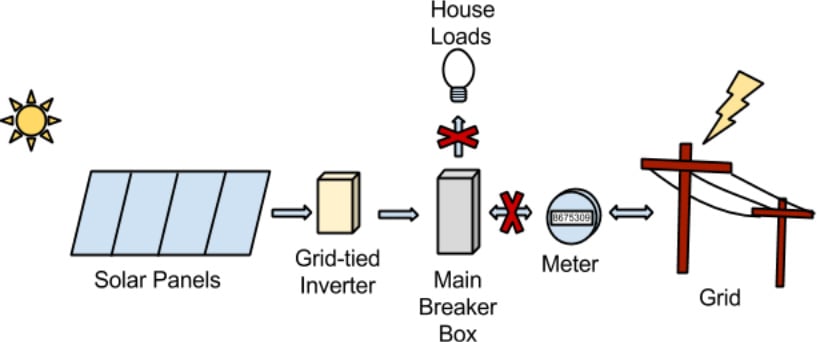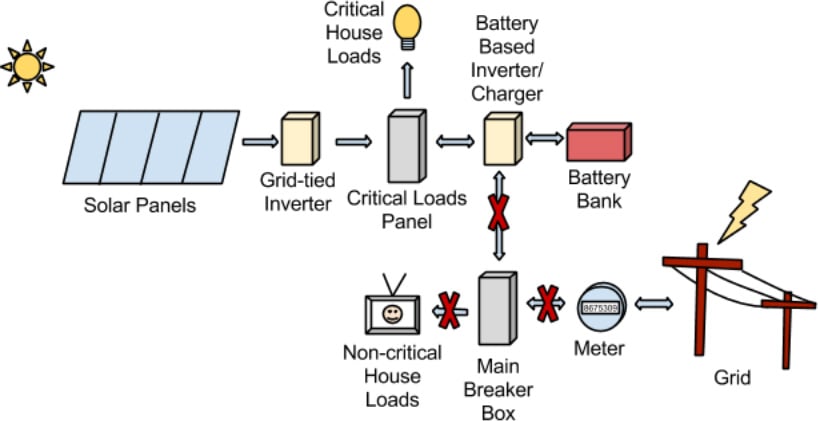AC COUPLING-ADDING BACKUP TO YOUR GRID-TIED SOLAR POWER SYSTEM
AC COUPLING
Adding backup to your grid-tie solar power system
WHAT IS AC COUPLING?Grid-tie systems are the most cost effective and easiest systems to install. Until the day the grid goes down, and your house is without power while your neighbor with the loud, smelly generator is sitting in their house drinking frozen margaritas and watching TV, and your spouse is giving you the evil eye. What do you do now? No, you can't run an extension cord to your neighbor's house and hope they don't notice (trust me, I know). UL requirements cause grid-tie systems to shut down immediately if the grid goes out to prevent accidentally electrocuting the lineworkers while they are working on the power lines to restore power.

The good news is that there is a way to add battery backup to your existing grid-tie system without having to get rid of your existing equipment and start over. AC Coupling uses your existing system to feed power into a battery based inverter/charger to charge the battery bank. You keep your existing system exactly as is, except you add a battery based inverter/charger and battery bank. The battery bank doesn't need to be huge, just large enough to run your critical loads during a power outage; the well pump, fridge, furnace system's electrical components, a few lights, and charger for your your cell phone.

An inverter/charger connects to an additional electrical sub-panel called the "critical loads panel." It's the breaker box that the most important circuits are connected to. The inverter is also connected to the grid. When the inverter detects that the grid is out, it turns off any connection to the grid, and only powers the items wired into the critical loads panel. Therefore it complies with the requirement to not send power down the lines, but allows you to have some power in your house.
In an AC Coupled solar system, your existing grid-tie inverter is also connected to the critical loads panel. When the grid is up, it passes power through the inverter, out to the rest of the house, and any excess power gets sent to the grid to spin the meter backwards, same as usual. But when the grid goes out, the transfer switch flips, and it turns off any connection to the grid, and connects only to the critical loads panel. Since the grid-tie inverter is also connected there, it instantly sees the output from the inverter, and thinks it's the grid. If the sun is shining, the grid-tie inverter doesn't turn off. It keeps sending solar power to the inverter/charger to charge the battery bank. So you are powering your critical loads off the battery bank, while the solar panels are recharging the batteries during the day. Once the grid comes back up, the transfer switch flips back, and the grid-tie inverter goes back to powering the whole house and spinning your meter backwards. Because the AC charging is being backfed through the AC output, it does not use the 3-stage charger that is in the AC input. Each inverter/charger manufacturer prevents the batteries from over-charging differently. There are pros and cons to each way.
Outback Power Radian Inverter/Chargers use a relay triggered by their Aux output signal. When the battery voltage hits a high setpoint, the relay opens and disconnects the grid-tie inverter from the system, stopping the charge. It won't turn back on until the battery voltage hits a low setpoint.
Schneider Electric's Conext XW + Inverter/Chargers detect that the battery bank is getting full and slightly shifts the frequency of the AC output. Since the grid-tie inverter is always checking the quality of the AC source it is connected to, it will think there is something wrong with the grid and shut off. It will turn back on five minutes later to check to see if it has corrected itself. Once the battery voltage gets lower, the inverter/charger will shift the frequency back to an acceptable range, and the grid-tie inverter will stay on. The shift in frequency is small enough that it won't bother the critical loads running off it, just enough to turn off the grid-tie inverter.
Magnum Energy MSPAE Inverter/Chargers do a combination of shifting the frequency and also using a diversion (or dump) load to burn off the extra stored power in the battery bank, making room for more.
SMA (Sunny Island Inverter/Chargers) is the only manufacturer which makes both the grid-tie inverter and the inverter/charger, allowing for a high level of communication between the two inverters. This communication link allows them to adjust power output during power outages, by putting the grid-tie inverter in 'stand-alone' mode. Then the frequency shift signals the inverter/charger to adjust power output levels according to load demand.
* It is important to note that the grid-tie inverter manufacturers have different views and methods regarding AC Coupling. Some grid-tie inverter manufacturers do not support AC Coupling at all, and may VOID the warranty on their inverter/chargers if you do it. Others, such as Enphase's micro inverters have gone through a test cycle with the major inverters and are fully supporting it.
Tel: (+506) 7037-8077 or Toll Free: 1(800) 2130227
Solar Systems in United States & Latin America



